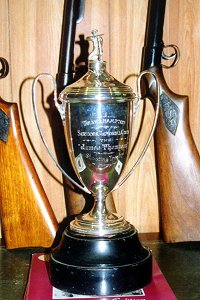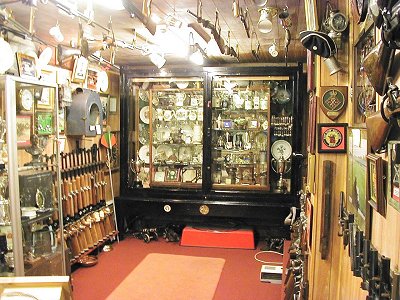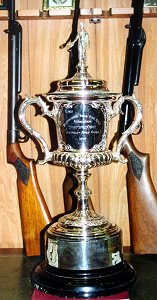COMPETITIVE RIFLE SHOOTING IN WOLVERHAMPTON FROM 1945
by Frank Spittle
5. The developing sport
Wolverhampton dominated the Staffordshire inter-town shooting
championships in the sixties, winning the Pidduck Shield in 1966 for the
ninth time in succession.

The Wolverhampton Services Memorial Club. The James
Thompson Shooting Trophy. |
Local county and industrial leagues, Midland and National, both
team and individual, gave a great choice of participation to the growing
interest in rifle shooting in the town. At times there did appear to be
just too many target cards and competitions to be shot, as the majority
had to be shot within a date specified on the Witness Sheet. It would
not be possible for teams to compete always shoulder to shoulder, so the
Postal Shoot enabled teams many miles apart from each other to
shoot, under witness, and then dispatch the shot cards to an
independent scorer for the result.
To some perhaps, not satisfactory, but the system
worked all over Britain. And the N.S.R.A. rules were strict; anyone
caught cheating was banned for life, his name was published in the house
magazine The Rifleman, and there was no appeal. Drastic but
effective, the sport therefore kept its house in order to see that there
was very little chance under the rules for misdemeanour. |
| Like darts and dominoes, results and league tables appeared in the
Express and Star.
Photographs and reports did a lot to bring
shooting to the public as a great sport, but as publicity is the life
blood of sport, it can also be a double edged sword if it is not the
right sort, as the unfortunate Hungerford and Dunblane incidents have
since proved. |

A view of one end of the Museum of
Marksmanship, established by Frank Spittle in Wolverhampton. |
| Today the sport is directed to the pursuit of excellence, at the
recognised international distance of ten metres. At the international
level, leather clad in special jacket, trousers, shooting boots and
glove, the competitive air gunner is faced with a target having a pin
head at its centre and no margin for error. Recoilless air rifles of
German manufacture, Walther, Anschutz, Feinwerkbau and Hammerli,
dominate the world market and international events such as the Olympics
and World Championships. A fully equipped competitor could have laid out
over £2000 to compete in this class of air rifle shooting. The clothing that the general shooting fraternity wore also
changed greatly over time. The old battle-dress blouses, with patches on
the elbows and shoulder, or sports coat with individual elbow pads, that
followed the "as issued" military instructions of the war years, were
set aside for the genuine shooting coat now available through the
N.S.R.A.. Even this had to take second place to the superior American
"Tenex" model. An old motorbike gauntlet with the fingers cut off, was
discarded for a "proper" shooting mitt or glove. Purpose made shooting
mats now accompanied the rifleman instead of the bit of kitchen carpet
or ex-army groundsheet; the shooter now was none too happy to get his
new shooting gear dirty in the grubby indoor rifle ranges of the day,
that for many years had not changed to accommodate new people into
shooting.
|

Wolverhampton Small Bore Rifle Association
Championship Trophy, Aldersley Range, 1974. |
With the arrival of new rifles etc, there was a change in one piece of
shooting equipment that had quite an effect on the scores of the day.
This was the adoption of the Single Point Rifle. Sling Rifles in
the two great world wars, and before, were carried slung from the
shoulder on an army webbing sling fastened to two swivels, one at each
end of the gun. Therefore it followed that this essential part of the
equipment should be used in steadying the rifle when aiming. Wrapped
around the right forearm it did the job very well for the job it had to
do. Of course, more comfortable two point slings were manufactured out
of canvas.
But both sorts were to accommodate the old English position
of shooting in the prone position with legs apart, and arms splayed in a
low position. This position was used for obvious reasons of safety in
the field of battle, and to take up the not inconsiderable recoil if it
was a 303 calibre Lee Enfield. |
| The new match rifles from B.S.A. and Germany were much heavier than the
303 Enfield, up to 12 or 14 lbs in weight, so one had to get one’s arm
well underneath the "forend", or front of the rifle to support it. The
new single point sling allowed this. Without getting too technical, it
also allowed the rifleman to adopt the Estonian Position, laying over to
the left in the sling with the right knee drawn up. Another position
adopted in the early days was with the body in a straight line to the
target with one leg hooked over the other; the main reason for this
position was lack of space on the firing point for clubs with a large
membership. Many of the best shooters used this way of shooting very
successfully indeed. The acceptance of old indoor rifle ranges by the "it's always been like
it" brigade, limited new membership to the "dedicated" shooter. There
was very little comfort for the shooter let alone the spouse or
spectator, though it must be said that watching a shooter in action was
a nothing experience such as watching paint dry. Nevertheless that side
of club shooting was sadly neglected, which eventually had great effect
on the sport of competitive shooting pursued in Britain. Some form of
extra comfort on some of the ranges was gained by walling the range off
from the firing point, and warming just that enclosed area of the prone
rifleman. Had attention to the service/hospitality side, with a more
pronounced family involvement, been considered, as was normal on the
Continent, the sport would have grown in the same way that it has
abroad. Continental clubs thrived on the capital a good social side that
the club generated, and many thousands of these European shooting
centres, have the services, surroundings and atmosphere of an exclusive
international golf club.
|
 |
|
 |
Return to the
previous page |
|
Proceed to the
next page |
|



